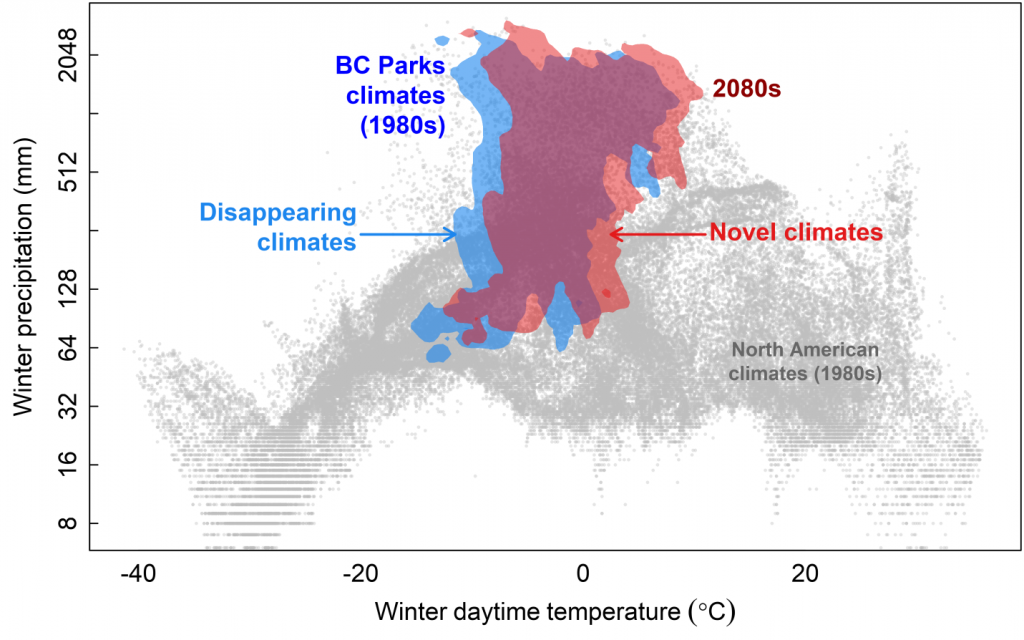BC Parks and the projected climates of the 21st century
Categories:
B.C.’s impressive protected area system is comprised of protected areas that were established to protect representative ecosystems in the province, and specific habitat values characterized by the vegetation and wildlife that live there. The boundaries of these protected areas are fixed, but as the climate changes, so will the species, ecosystems and communities that are captured by those boundaries.
But, how much change are we talking about? Will we see major changes to our much-loved parks over the course of this century? How will these changes impact the way parks are managed in the future? These are questions that Colin Mahony, working with Sally Aitken at the UBC Department of Forest and Conservation Sciences, have explored in detail with support from the BC Parks Living Lab Program for Climate Change and Conservation.
Mahony and Aitken’s research shows the extent to which historical climates will “disappear” from a protected area, and how new, or “novel” climates are anticipated to emerge. In fact, climatic displacement is already underway throughout B.C.’s protected area system. By 2050, even under the scenario of moderate global emissions reductions, essentially none of the climates of B.C.’s protected areas will be in their historical climatic zones, and 75% of protected areas within the system will have climates that are novel to and disappearing from individual park boundaries.
The figure below shows the winter climates of B.C. (dark gray) in the context of all the North American winter climates (light gray). Because B.C. is very diverse, it covers a large fraction of the North American climates.

The second figure below shows all of British Columbia’s protected area network in the coloured polygons. Because the protected area network is well representative of the entire province, this figure is similar to the dark gray image in the previous graph. We can see the winter climates British Columbia could experience within our protected area system by the end of the century.
The blue edges show the climates that will disappear from the current protected area footprint and the pink edges are new combinations of winter temperature and precipitation (i.e. climate) that our protected area system has not experienced before. The future conditions in the wettest portions of the protected area system, in the upper area of the climate envelope, are novel even to North America.

Analysis of Carmanah Walbran Provincial Park and the Garibaldi Protected Area complex
In addition to assessing climatic shifts and changes at the level of the protected area system, Mahony and Aiken’s research completed case studies of individual protected areas and clusters of protected areas, demonstrating the highly variable nature of climatic displacement within individual parks.

As shown in the figure above, the winter climates in the Carmanah Walbran Provincial Park have no overlap between 1980 and 2080. All the 1980 climates are disappearing from the park and all the 2080 climates are new. What will that mean for the plant and wildlife species that have lived there for centuries?
The Garibaldi protected area complex which includes Garibaldi, Pinecone Burke, and Golden Ears parks is larger and more diverse than Carmanah Walbran park. Climate and habitat are closely correlated. The Garibaldi complex demonstrates that a larger, more complex protected area has more opportunity for overlap between past climates and future climates. It will be easier for species to find their way to a compatible climate in the larger complex.
This research can also be used to identify priorities for completing climate vulnerability assessments, and to initiate discussion on new management practices that may be required to respond to these challenges.
At the park level, the research can help park managers adjust their understanding of the future ecosystems in the individual parks they manage, the vegetation and wildlife that might be found there in the future, and even recreation patterns and opportunities that may be presented by these changes.




